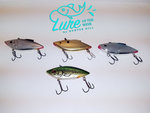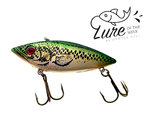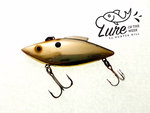 Narrowsburg
NarrowsburgLight Rain Fog/Mist, 43°
Wind: 8.1 mph
 Narrowsburg
NarrowsburgThe Rat-L-Trap, pronounced ‘rattle trap,’ is a kind of crankbait, designed without a lip. Instead, it has a tie-on ring located just past the top of the head and a flat ridge along the …
Stay informed about your community and support local independent journalism.
Subscribe to The River Reporter today. click here
This item is available in full to subscribers.
Please log in to continue |




 The Rat-L-Trap, pronounced ‘rattle trap,’ is a kind of crankbait, designed without a lip. Instead, it has a tie-on ring located just past the top of the head and a flat ridge along the top of the lure that slopes outwards once past the tie-on. What this does is forces the lure to lean forward naturally because the tie-on is not on the nose, can it maintains that tilted orientation from the down pressure of passing water along the top of the flattened head of the lure. The body of the lure is a pointed oval approximate to the size of a feeder fish. On many Rat-l-traps there are protruding bumps along the gills to provide dimension however other more simple models do not and merely paint the base color throughout the body. The patterns available for Rat-l-traps are abundant and involve combinations of classic paint patterns and modern technology like holographic scale patterns, blood spatter on the gills, fluorescence, glitter etc. All Rat-l-traps come with two treble hooks, one in the front and the other in the rear. As they swim these hooks appear in the region where fins and a tail would be, thus making aesthetic a deadly weapon. On the head of almost all of these lures you will see an eye. The eyes are not painted on, but rather stick-on eyes, which I personally prefer.
The Rat-L-Trap, pronounced ‘rattle trap,’ is a kind of crankbait, designed without a lip. Instead, it has a tie-on ring located just past the top of the head and a flat ridge along the top of the lure that slopes outwards once past the tie-on. What this does is forces the lure to lean forward naturally because the tie-on is not on the nose, can it maintains that tilted orientation from the down pressure of passing water along the top of the flattened head of the lure. The body of the lure is a pointed oval approximate to the size of a feeder fish. On many Rat-l-traps there are protruding bumps along the gills to provide dimension however other more simple models do not and merely paint the base color throughout the body. The patterns available for Rat-l-traps are abundant and involve combinations of classic paint patterns and modern technology like holographic scale patterns, blood spatter on the gills, fluorescence, glitter etc. All Rat-l-traps come with two treble hooks, one in the front and the other in the rear. As they swim these hooks appear in the region where fins and a tail would be, thus making aesthetic a deadly weapon. On the head of almost all of these lures you will see an eye. The eyes are not painted on, but rather stick-on eyes, which I personally prefer.
You may be asking yourself why such a simple sounding lure would be called a Rat-l-trap. What does the name have to do with its function? The Rat-l-trap is filled with tiny metal balls. As you handle the lure you cannot help but notice the sound that this lure will make. Much like a maraca, the high tenor rattle of the lure occurs with every movement it makes, not only on land but in the water. While the paint jobs on these lures will help in attracting fish, the rattle is what will do the work. Tie one on and throw it out there, they have a couple ounces of heft as you might expect and are only about three inches long. As you start the retrieve you may notice a slight wiggle in the line, a steady vibration if you will. As the lure swims, it wriggles fairly quickly left and right in a tight half inch to an inch of width. This wriggling then causes the metal balls within to rattle all the more creating a noise and vibration throughout the water. Often times, aggressive bass or walleye will hit this lure after sensing it on their lateral lines and hunting down the cause of the racket. The rattling mimics an injured fish that creates additional disturbance in the water in its frantic haste. Knowing this, I like to reel it in slightly more quickly than other lures, stopping every ten to fifteen yards to allow the bait to pause and ‘catch a breath’ while the lurking predators close the gap or perhaps decide to take the bait. Since this is a hollow lure most of them are floating lures, however I believe there are sinking Rat-l-traps as well. Understand which kind you have before casting and that will help you to know how it needs to be handled around underwater structure.
I like to use it next to a spoon because it’s a “lightning and thunder” approach
Since this lure is so loud though, I like to use it in more open, deeper water. Not that it can’t be used in rivers and small ponds, absolutely it can, but I find it really capitalizes well in big water… with big fish! I’ll often tie one of these onto a trolling line. It can produce well next to a large spoon or even by itself. I like to use it next to a spoon because it’s a “lightning and thunder” approach. The Rat-l-trap will bring the ‘thunder’, noise, and the spoon brings the ‘lightning’, or flash. Together I find that they produce best on a calm day, of course you need the light to really utilize the spoon to its fullest as it catches the light and reflects it down into the water. The Rat-l-trap can be used at night though since it relies on noise as an attractant rather than exclusively sight. The noise isn’t the only component to successfully using this lure though. Be careful if you see it swimming off to one side. The treble hooks have a habit of sometimes catching on the line and messing up the swim pattern. Movement in the water like this will still make the rattle, but once a fish comes upon the lure, it will turn away, spooked by the unnatural appearance of the lure. With any lure it is important to maintain the natural swim patterns of the bait, lest it appear to be a hunk of metal or plastic being drug by a boat. Fish are not as stupid as we would hope them to be. It takes correct technique and execution to capitalize on this and any other lure out there.
So go pick one up, I’ve got some plain silver and gold ones, and a green bass patterned one that seems to do well for me. Try different colors and locations and see what works for you.
*If you have any luck with the lure of the week, feel free to email your pictures to events@riverreporter.com for an opportunity to share them on our website. If you have a favorite kind of lure we haven’t reviewed yet, feel free to send that lure to our office at PO box 150 Narrowsburg, NY 12764. We will add it to our weekly reviews and share the results. Check back each week on Fridays to see the new lure of the week!
Comments
No comments on this item Please log in to comment by clicking here